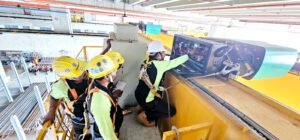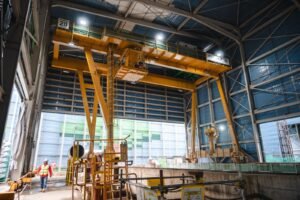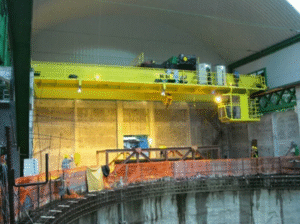Uncategorized
Semi Gantry Cranes vs. Full Gantry Cranes: What’s the Difference?
A gantry crane is designed to lift things using a ground-level track or rail system. You can see these powerful vehicles in use in warehouses, along harbours, in construction areas, and at transport facilities requiring the handling of heavy materials. The system operates as a horizontal beam held up by legs on each end, and a hoist and trolley move along it to transport various types of loads.
Some main components are a thick beam, a hoisting mechanism to lift, and a trolley for moving things sideways. Most setups also feature wheels, a dedicated runway system, and an electrical power supply to handle operations smoothly and safely. Gantry cranes are your go-to solution when you need reliable heavy lifting capability.
Understanding Full Gantry Cranes
Full gantry cranes feature a complete frame structure with legs that run on floor-mounted rails on both sides. You’ll recognise them by their distinctive inverted U-shape that spans across your entire work area. These robust systems typically use a double girder design to maximise strength and stability.
It is important to install tracks or rails on each side of where the cranes will be active. These are most effective in wide open spaces, industrial fabrication areas, and places where heavy machines are handled. Gantry cranes are also used to lift and move large equipment over far distances.
What Is a Semi Gantry Crane?
The design of a semi gantry crane allows one side to travel on a floor rail while the other travels up and down a rail that is installed onto the building. This type of arrangement makes it possible to use your space in different and convenient ways compared to others. You’ll find these especially useful when machinery or workflow requires access along one side of your workspace.
Semi-gantry cranes don’t need a runway, so they conserve space along their full reach. A common setup of a semi-gantry crane includes parts like a strong hoist trolley, a beam that supports the weight, a chain hoist for lifting, a motor system, and a reliable wire rope for smooth lifting. This design helps you save cash on the installation and still offers the lifting abilities you require, with little effect on your factory’s layout.
Key Differences Between Semi Gantry and Full Gantry Cranes

- Configuration: Full gantry uses floor-mounted rails on both sides; semi gantry uses one floor rail and one elevated runway.
- Space Requirements: Semi gantry cranes free up valuable floor space; full gantry cranes need clear pathways on both sides.
- Building Integration: Semi gantry connects to your existing building structure; full gantry operates independently.
- Installation Complexity: Semi gantry typically requires less extensive groundwork but needs suitable building support.
- Cost Factors: Semi gantry often costs less initially due to reduced rail requirements and civil works.
- Application Suitability: Semi gantry works best alongside walls or existing structures; full gantry excels in open areas.
- Weight Capacity: Full gantry generally handles heavier loads and larger spans.
- Operational Footprint: Semi gantry creates a more compact operational zone, improving workflow in tight spaces.
Semi-Girder Gantry Cranes from Jenmon: Your Ideal Solution
Looking to save money and valuable space? Our Jenmon Semi-Girder Gantry Cranes offer you a smart alternative when you’ve got machines lined up along your factory edges.
The clever design features one support leg that travels along floor-level rails while the opposite side glides smoothly on an elevated runway beam. This arrangement is particularly effective for wider manufacturing spaces. You’ll benefit from needing just two operational zones instead of paying for expensive continuous runway beams and support columns running through the middle of your production area.
We’ve engineered our Semi-Girder Gantry Cranes to adapt to numerous industrial settings. By carefully considering your unique factory configuration and workflow patterns, we deliver solutions that perform brilliantly whether you’re operating in enclosed workshops or outdoor yard environments.
Enhance your system with these valuable additions:
- Illumination with Girder-Mounted Lighting
- Warning Systems with Audio-Visual Alerts
- Safety Equipment, including Rail Sweepers
- Precision Control via Ultrasonic Sensor Technology
Final Thoughts: Full vs. Semi Gantry Cranes—Which One Works for You?
Your ideal gantry system depends entirely on your specific operational needs and facility layout. Semi gantry cranes offer brilliant solutions when you need flexibility in limited indoor spaces, have existing structures to leverage, or want to minimise installation costs. They’re perfect when machinery must align along facility walls.
Full gantry systems excel in open environments where maximum lifting capacity and spanning capability are essential. They provide unmatched performance for heavy-duty outdoor applications without relying on building support.
Contact us at Jenmon for expert guidance in selecting the perfect crane solution. We’ll assess your specific requirements and recommend the right system that balances your operational demands with practical considerations. Your perfect lifting solution starts with understanding these key differences.




